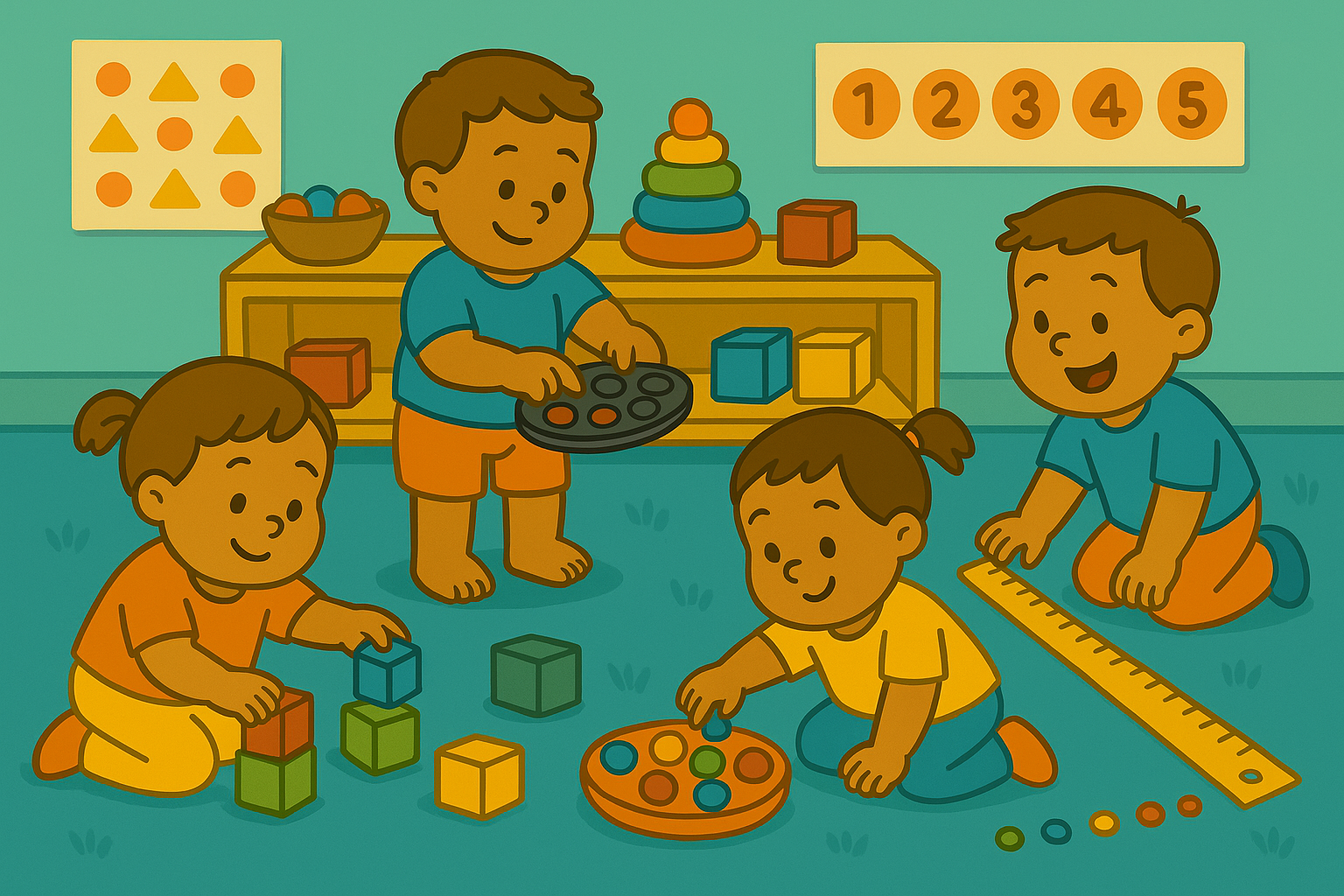Play-Based Math: Counting, Sorting, Measuring Through Fun
Play-Based Math: Counting, Sorting, Measuring Through Fun
Math concepts begin long before children recognize numbers on a page. They emerge through touch, movement, repetition, and hands-on play. When toddlers stack blocks, pour water between cups, match socks, or notice patterns in nature, they’re building foundational math thinking. Play-based math helps children develop number sense, problem-solving, measurement skills, and spatial awareness naturally—without pressure, worksheets, or rigid expectations.
Young children learn math best when they interact with real objects and meaningful experiences. They need opportunities to explore materials freely, try ideas, make mistakes, and discover relationships between items.
Why Play Is the Perfect Foundation for Early Math
Play activates the same cognitive skills children need for mathematics—attention, pattern recognition, sequencing, problem-solving, and spatial reasoning. When math emerges naturally in play, it feels relevant and exciting rather than abstract.
Kids aren’t just playing when they build towers or sort treasures—they’re constructing meaningful math knowledge:
Recognizing quantity
Understanding order and size
Experimenting with cause and effect
Observing patterns
Comparing measurements
Most importantly, play-driven math feels like discovery, not instruction. Children take the lead, follow their curiosity, and develop skills at a pace that feels comfortable and joyful.
Creating a Math-Rich Environment at Home
A math-rich environment doesn’t require special tools or expensive materials. Everyday items—containers, snacks, toys, nature objects—offer endless opportunities for counting, sorting, comparing, and measuring.
A math-rich space might include:
Easy access to loose parts
Open shelves with baskets of objects
Tools for measuring (cups, spoons, non-standard units)
Simple puzzles and blocks
Everyday household items for comparing size and weight
Children thrive when materials are visible and accessible. They’re more likely to initiate math-based activities when they feel empowered to explore independently.
Counting Through Playful, Hands-On Activities
Toddlers learn early number concepts best when counting feels like part of the game.
Invite children to count:
Blocks as they stack
Steps as they climb
Cars or puppets during play
Crayons in a cup
Snacks (berries, pretzels, crackers)
Toy animals walking into a “barn”
Balls rolling down ramps
The goal isn’t memorizing numbers—it’s understanding that numbers represent quantities. Counting in play builds this concept long before paper-and-pencil math appears.
Sorting and Classifying to Build Strong Math Foundations
Sorting is one of the earliest and most meaningful math activities for young children. When kids group objects by size, color, shape, or category, they build skills essential for patterns, early geometry, and even later algebraic thinking.
Sorting activities might include:
Matching socks
Grouping toy animals by type
Sorting buttons by size
Arranging blocks by shape
Creating “collections” from nature (stones, leaves, pinecones)
Children feel powerful when they organize the world around them—and this sense of order supports developing number sense.
Exploring Patterns to Build Cognitive Flexibility
Patterns help children understand predictability, sequencing, and relationships between elements. Play makes pattern exploration both intuitive and exciting.
Try introducing:
Color patterns (red-blue-red-blue…)
Movement patterns (jump-clap-jump-clap)
Sound patterns (tap-tap-pause, tap-tap-pause)
Object patterns using loose parts
Puppet dance patterns, where puppets repeat silly moves
Patterns lay the foundation for later math concepts like skip counting and multiplication—but in early years, they’re simply joyful and engaging.
Measuring Through Everyday Exploration
Measurement begins long before rulers and scales. For toddlers, measurement means comparing, estimating, and investigating size, capacity, and length.
Everyday measuring play might include:
Filling and dumping cups of water
Comparing who stacked the tallest tower
Scooping sand with different spoons
Testing which container holds more blocks
Using their hands or feet as “measurement tools”
These early experiences make abstract math feel meaningful and concrete.
Using Loose Parts to Encourage Math Curiosity
Loose parts are incredibly effective for early math because they can be counted, arranged, grouped, compared, and transformed.
Offer items like:
Shells
Wooden rings
Bottle caps
Corks
Pom-poms
Smooth pebbles
Popsicle sticks
Kids naturally use these materials to create patterns, sort them, count them, or build structures. Loose parts inspire the open-ended exploration described in Encouraging Creative Thinking Through Open-Ended Play, where children make the rules.
Building Spatial Awareness Through Construction Play
Block building, magnetic tiles, and stacking toys help children develop spatial reasoning—one of the strongest predictors of later math success.
Through construction, children learn:
Balance and stability
Shape relationships
Symmetry and structure
Cause and effect
Depth, height, and width
Kids experiment with geometry every time they stack a tower or fit shapes together.
Math Through Pretend Play and Storytelling
Pretend play is a surprisingly rich source of early math.
Try incorporating math into:
Play kitchens (measuring ingredients, setting “orders”)
Puppet shops (counting items, making “payments”)
Doctor play (measuring height, doses, temperatures)
Road play (spacing cars, building routes)
Storytelling (“How many animals are in the barn now?”)
Children make sense of numbers when they use them to bring their stories to life.
Asking Questions That Deepen Math Thinking
Open-ended questions help children explore math concepts without feeling tested. Instead, questions feel like invitations to wonder and discover.
Try asking:
“How many do you think you have?”
“What changed when you added one more?”
“Which one is bigger? How do you know?”
“What happens if you turn it this way?”
“How can we make these equal?”
These questions align with the gentle, curiosity-driven style in Using Puppet Conversations to Teach Vocabulary, where adults support—but don’t dominate—the child’s thinking.
Raising Curious, Confident Young Mathematicians
Play-based math sets children up to approach numbers with confidence, curiosity, and joy—not fear or pressure. When kids count, sort, measure, build, compare, and experiment freely, they develop strong number sense and flexible problem-solving skills that support them long into their school years.
Children don’t need worksheets to learn math—they need opportunities to explore, imagine, and wonder. Through playful experiences and supportive environments, kids become confident mathematicians who understand that math isn’t just something to “learn”—it’s something they can do.
This content is for educational purposes and is not a substitute for professional medical or psychological advice.
Popular Parenting Articles


